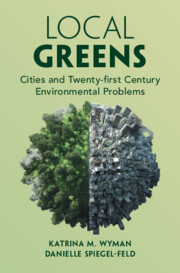Book contents
- Local Greens
- Local Greens
- Copyright page
- Dedication
- Contents
- Figures
- Tables
- Photographs
- Acknowledgments
- Introduction
- 1 A Brief History of Cities in Environmental Policy
- 2 An Analytical Framework
- 3 Local Environmental Protection in NYC
- 4 Decarbonization Efforts in NYC
- 5 Adapting to Climate Change in NYC
- 6 An Urban Climate Change Agenda for the Early Twenty-First Century
- Coda
- Notes
- Index
Introduction
Published online by Cambridge University Press: 11 October 2025
- Local Greens
- Local Greens
- Copyright page
- Dedication
- Contents
- Figures
- Tables
- Photographs
- Acknowledgments
- Introduction
- 1 A Brief History of Cities in Environmental Policy
- 2 An Analytical Framework
- 3 Local Environmental Protection in NYC
- 4 Decarbonization Efforts in NYC
- 5 Adapting to Climate Change in NYC
- 6 An Urban Climate Change Agenda for the Early Twenty-First Century
- Coda
- Notes
- Index
Summary
Most American environmental law scholarship overlooks the role of cities in environmental law and policy. Instead, scholars typically focus on federal environmental law. This book emphasizes the potential for leading cities to play a meaningful role in protecting the environment. It offers a framework for understanding the factors that give to, and constrain, local environmental law and policy. Local environmental policy may emerge from the top from local elites centrally concerned with local economic development, and from the “bottom up” from community groups. However, there are limits on the costs that local governments can impose on local actors to address global environmental problems, such as limiting climate change, given the overriding importance that local governments attach to promoting economic development. The book offers case studies of local environmental efforts in New York City to illustrate the promise and limitations of local environmental policy. Taking into account the opportunities and constraints at the local level, the book outlines a high-level agenda of actions that local governments in large cities should undertake to adapt to climate change and contribute to decarbonization.
Information
- Type
- Chapter
- Information
- Local GreensCities and Twenty-first Century Environmental Problems, pp. 1 - 16Publisher: Cambridge University PressPrint publication year: 2025
Accessibility standard: WCAG 2.0 A
Why this information is here
This section outlines the accessibility features of this content - including support for screen readers, full keyboard navigation and high-contrast display options. This may not be relevant for you.Accessibility Information
Content Navigation
Allows you to navigate directly to chapters, sections, or non‐text items through a linked table of contents, reducing the need for extensive scrolling.
Provides an interactive index, letting you go straight to where a term or subject appears in the text without manual searching.
Reading Order & Textual Equivalents
You will encounter all content (including footnotes, captions, etc.) in a clear, sequential flow, making it easier to follow with assistive tools like screen readers.
You get concise descriptions (for images, charts, or media clips), ensuring you do not miss crucial information when visual or audio elements are not accessible.
You get more than just short alt text: you have comprehensive text equivalents, transcripts, captions, or audio descriptions for substantial non‐text content, which is especially helpful for complex visuals or multimedia.
Structural and Technical Features
You gain clarity from ARIA (Accessible Rich Internet Applications) roles and attributes, as they help assistive technologies interpret how each part of the content functions.
